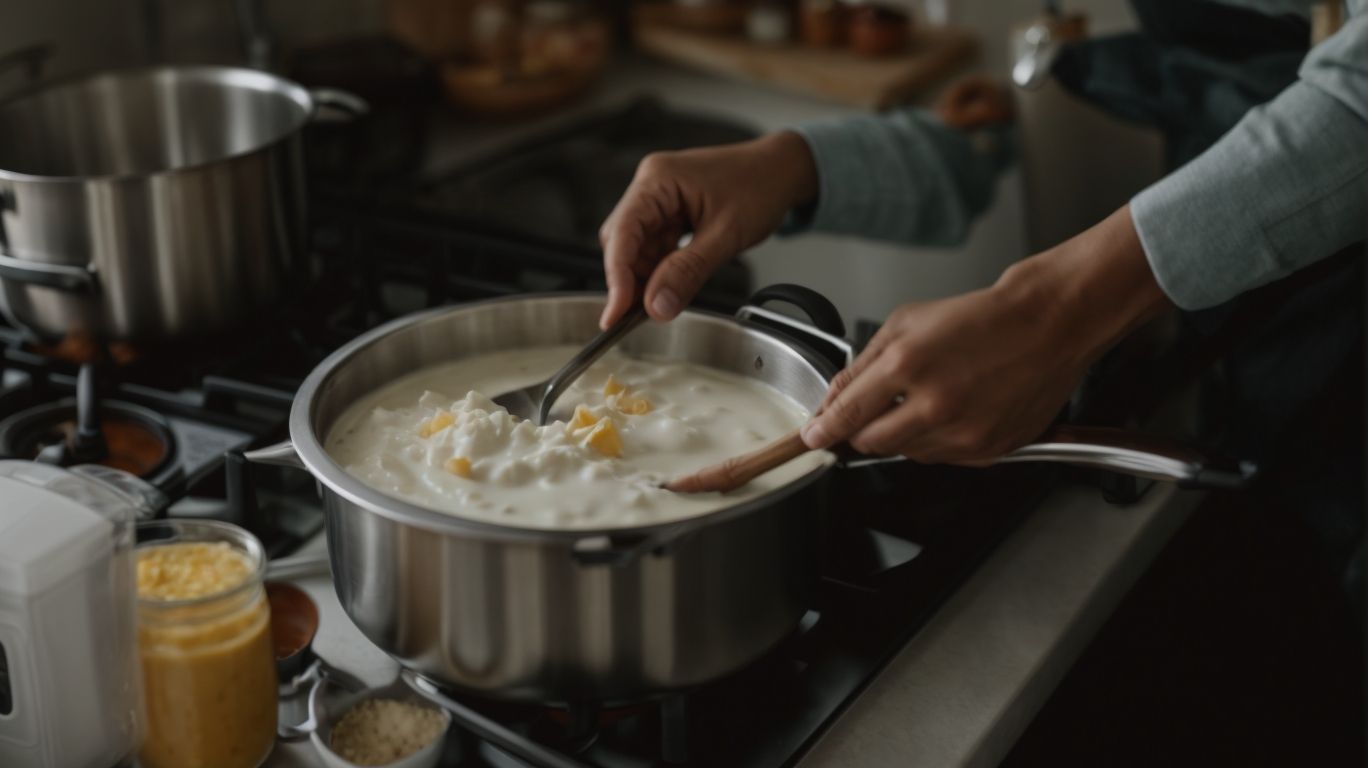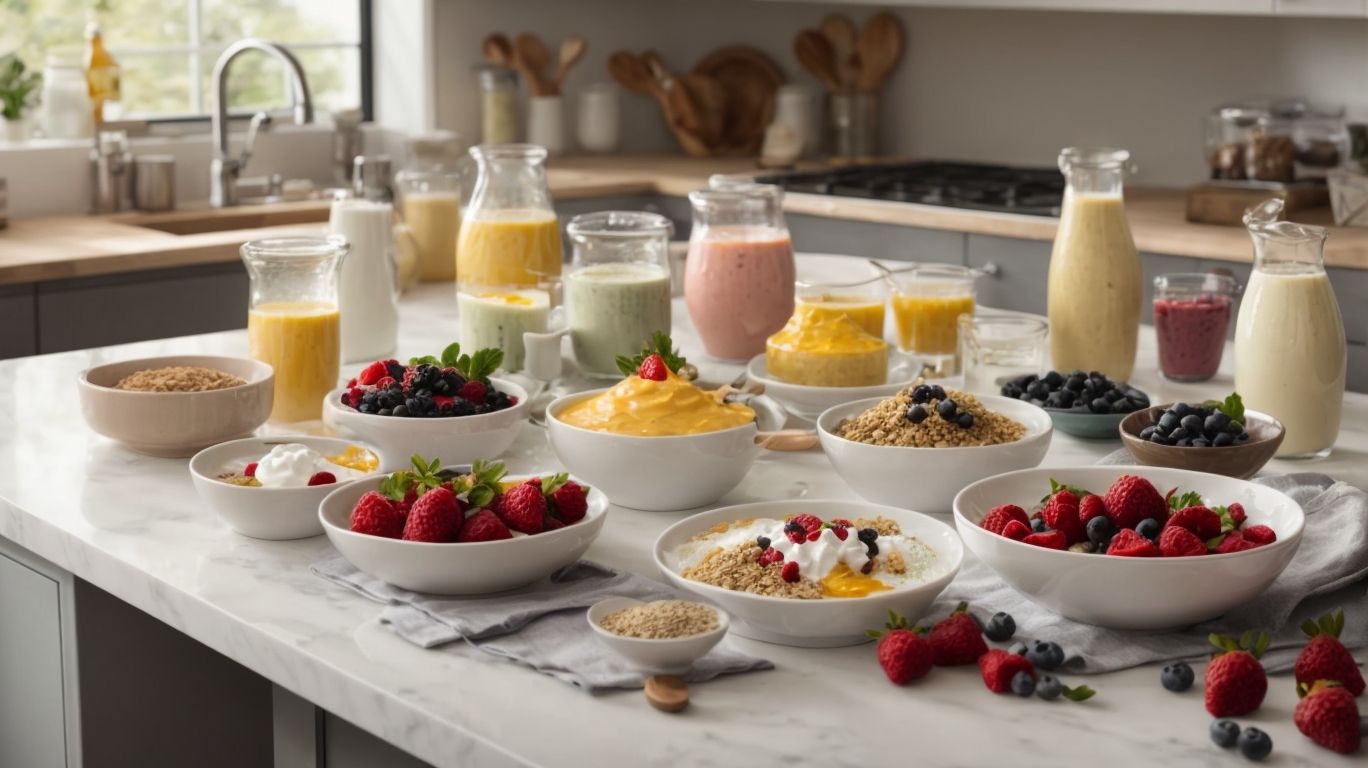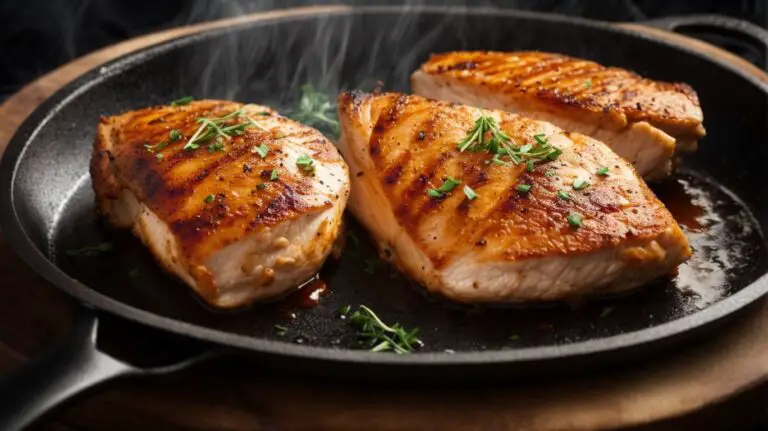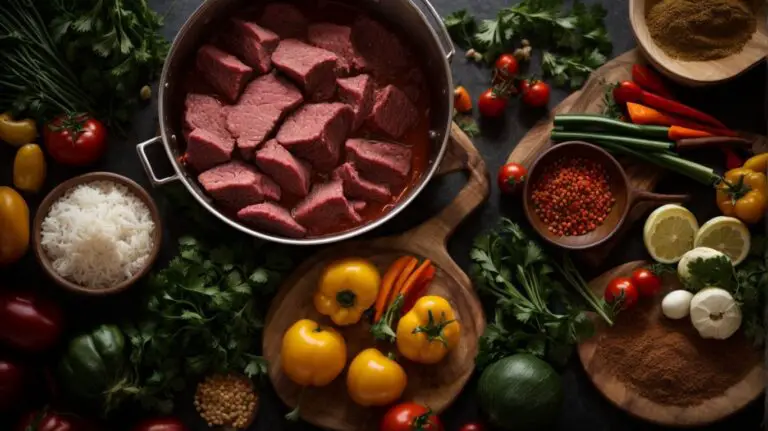How to Cook With Yogurt Without Curdling?
Yogurt is a versatile ingredient that can add creaminess and tanginess to a variety of dishes.
Discover the world of yogurt, from how it’s made to the different types available. Learn why yogurt is a great addition to your cooking arsenal and get tips on how to prevent it from curdling.
Find inspiration with a list of delicious dishes you can make using yogurt. So, start experimenting with this delicious ingredient!
Key Takeaways:
What is Yogurt?
Yogurt is a dairy product made by fermenting milk with live bacterial cultures, resulting in a tangy and creamy texture.
During the yogurt fermentation process, the live bacterial cultures, typically consisting of Lactobacillus bulgaricus and Streptococcus thermophilus, play a crucial role. These beneficial bacteria convert the lactose in the milk into lactic acid, which thickens the mixture and gives yogurt its characteristic tanginess.
The consistency of yogurt can vary depending on factors like fat content, milk type, and straining methods. Greek yogurt, for example, is strained to remove whey, resulting in a thicker, creamier texture.
The flavor profile of yogurt can be influenced by factors such as fruit additives, sweeteners, and additional probiotic strains. From traditional plain yogurt to exotic fruit-infused varieties, there is a wide range of flavors to suit diverse preferences.
How is Yogurt Made?
The process of making yogurt involves fermenting milk with live bacterial cultures, such as Lactobacillus bulgaricus and Streptococcus thermophilus, at a controlled temperature.
Once the milk is prepared by heating it to a certain temperature to kill any harmful bacteria, it is cooled down before adding the live cultures. The temperature control is crucial throughout the process to ensure the optimal environment for the cultures to thrive. By maintaining the right temperature, typically around 110°F (43°C), the fermentation process can occur efficiently, transforming the milk into yogurt. During fermentation, the cultures consume the lactose in the milk and produce lactic acid, which gives yogurt its characteristic tangy flavor and thick texture.
Types of Yogurt
Yogurt comes in various types, including full-fat yogurt, non-fat yogurt, and dairy-free yogurt substitutes like tofu or coconut milk yogurt.
Full-fat yogurt, known for its rich and creamy texture, offers a more indulgent option for those looking for a satisfying treat. On the other hand, non-fat yogurt provides a lighter alternative that still delivers the tangy flavor and beneficial probiotics.
For individuals with lactose intolerance or vegan preferences, dairy-free options like tofu-based yogurt or coconut milk yogurt serve as excellent substitutes without compromising on taste or nutritional benefits. These alternatives cater to a wide range of dietary needs, ensuring that everyone can enjoy the goodness of yogurt in a way that suits their preferences and requirements.
Why Use Yogurt in Cooking?

Credits: Poormet.Com – Zachary Adams
Yogurt is a versatile ingredient in cooking, adding richness, creaminess, and a tangy flavor to a variety of dishes.
Along with its taste-enhancing qualities, incorporating yogurt into cooking also offers numerous health benefits. Yogurt is a rich source of probiotics beneficial for gut health, protein for muscle repair, and essential nutrients like calcium, potassium, and vitamins B12 and B2. Its creamy texture lends itself well to both sweet and savory dishes, making it a valuable substitute for higher-fat ingredients like cream or butter. From marinades to dressings, sauces to desserts, yogurt proves to be a versatile and nutritious addition to any culinary repertoire.
How to Prevent Yogurt from Curdling?
Preventing yogurt from curdling requires careful attention to temperature control, the addition of stabilizing agents like flour or cornstarch, and the use of acidic ingredients to maintain a smooth texture.
Along with temperature and ingredients, stirring yogurt gently while incorporating it into your recipes can also help prevent curdling. Another effective technique is to slowly introduce the yogurt into warm liquids or recipes with gentle heat to gradually bring it up to temperature. Consider using full-fat yogurt, as the higher fat content can often result in a creamier texture that is less prone to curdling.
Ensure that any dairy products or acidic ingredients added to the yogurt are at room temperature before mixing to avoid abrupt temperature changes that may lead to curdling. Pay attention to the expiry date of your yogurt and avoid using it if it is close to expiring, as older yogurt may be more prone to curdling.
Use Full-Fat Yogurt
Using full-fat yogurt in recipes can help maintain a creamy texture and reduce the likelihood of curdling due to its higher fat content.
When seeking to achieve a velvety consistency in dishes that call for yogurt, utilizing full-fat yogurt can be a game-changer. The richness and thickness provided by the higher fat content of full-fat yogurt create a luscious mouthfeel, elevating the overall experience of your culinary creations.
Moreover, full-fat yogurt imparts a subtle tanginess that enhances the flavor profile of both savory and sweet recipes, offering a pleasant contrast to other ingredients. Whether you are whipping up a creamy curry or a silky smooth dessert, incorporating full-fat yogurt can bring a new dimension to your cooking.
Temper the Yogurt
Tempering yogurt by slowly introducing it to warm ingredients at room temperature can prevent lumps and ensure a smooth consistency in sauces and dishes.
In the culinary world, tempering yogurt is a delicate process that requires patience and attention to detail. When tempering yogurt, it is essential to gradually mix it with the warm components to avoid sudden temperature changes resulting in curdling. This method ensures that the yogurt blends seamlessly into the dish, enhancing its texture and flavor. By tempering yogurt correctly, you can harness its creamy richness without compromising the overall consistency of the sauce or dish. The key lies in the slow and steady incorporation of yogurt into the warm mixture to achieve a velvety finish.
Add Yogurt at the End
Adding yogurt towards the end of the cooking process can minimize the risk of curdled textures and ensure a smooth incorporation of the ingredient into the dish.
Yogurt possesses natural emulsifying properties, which means it can blend seamlessly with other ingredients, enhancing flavors and textures.
By introducing yogurt at a later stage, you not only prevent unwanted separation but also infuse a creamy richness into your dishes.
This versatile dairy product can elevate both savory and sweet dishes, from sauces and soups to marinated meats and baked goods.
Use Low Heat
Cooking yogurt over low heat with gentle simmering and frequent whisking helps prevent the breakdown of protein strands and maintains a creamy texture in sauces and curries.
When cooking yogurt at high temperatures, the proteins within the yogurt can easily denature, leading to a grainy or separated texture in your dishes. By gently simmering the yogurt over low heat, you are allowing the proteins to stay intact, preserving their structure and resulting in a smooth, velvety consistency.
Whisking the yogurt frequently during cooking also plays a crucial role in maintaining its smooth texture. This process helps distribute heat evenly, preventing any part of the yogurt from overheating and curdling.
Add an Acidic Ingredient
Incorporating acidic ingredients like lemon juice or vinegar can help fix curdled yogurt and salvage the texture of a meal by balancing the pH levels and restoring creaminess.
When curdling occurs in yogurt-based dishes, it can be disheartening to see the texture compromised. With the addition of these acidic components, the imbalances that lead to curdling can be neutralized effectively. The acidity in ingredients like lemon juice or vinegar works to counteract the proteins’ separation in curdled yogurt, thereby facilitating a smoother consistency. This process not only rectifies the issue but also enhances the overall flavor profile of the dish by bringing a harmonious balance to the flavors.
What Dishes Can You Make with Yogurt?

Credits: Poormet.Com – Jonathan Clark
Yogurt is a versatile ingredient that can be used to create a wide range of dishes, including creamy salad dressings, marinades for meat, and rich sauces for various cuisines.
Its tangy flavor and creamy texture make it a perfect base for healthy and delicious recipes. You can whip up a refreshing tzatziki sauce for Mediterranean-inspired dishes, or use it to tenderize chicken in a flavorful Indian curry marinade.
Yogurt can add a subtle richness to desserts like cakes and muffins, creating moist and flavorful baked goods. Its versatility extends to breakfast dishes, where it can be used in smoothies, parfaits, and overnight oats for a nutritious start to the day.
Creamy Salad Dressings
Yogurt-based dressings add a creamy and tangy flavor to salads, enhancing the texture and taste of fresh ingredients like kale and other greens.
One of the key benefits of incorporating yogurt into salad dressings is the creamy consistency it offers without the need for heavy creams or mayonnaise. This not only helps in reducing the overall calorie content of the dressing but also provides a healthier alternative due to the probiotics found in yogurt. The tanginess of yogurt complements the natural bitterness of greens like kale, creating a harmonious balance of flavors in every bite. By incorporating yogurt-based dressings into your salads, you not only elevate the taste but also introduce a rich source of calcium and protein to your meal, making it a win-win for your taste buds and overall health.
Marinades for Meat
Yogurt marinades tenderize meat, infuse flavors, and help retain moisture, resulting in juicy and flavorful dishes suitable for grilling or roasting.
One of the key advantages of utilizing yogurt-based marinades for meats is their ability to break down tough muscle fibers, thereby tenderizing the meat and ensuring a more succulent bite.
The acidic nature of yogurt helps to enhance the overall flavor profile of the marinade, allowing the meat to absorb a rich combination of herbs, spices, and seasonings for a well-rounded taste experience.
The natural enzymes present in yogurt work to lock in moisture during the marinating process, preventing the meat from drying out during the cooking process.
Creamy Soups and Sauces
Yogurt enriches creamy soups and sauces with a velvety texture, adding a delightful tanginess and a hint of richness to comfort dishes.
When incorporated into soups and sauces, yogurt acts as a versatile ingredient that not only contributes to the overall smoothness but also helps balance out the flavors. The acidity in yogurt brings a lovely contrast to the richness of the dish, making each spoonful a burst of flavors. The creaminess of yogurt helps create a luxurious mouthfeel, elevating the dish’s appeal and making it a favorite among those seeking a balanced blend of flavors and textures.
Baked Goods
Yogurt can be used in baking to impart moisture, tenderness, and a subtle tang to cakes, muffins, and bread, enhancing the overall flavor profile of sweet treats.
One of the key benefits of using yogurt in baking is its ability to improve moisture retention in baked goods. The natural acidity of yogurt also helps activate baking soda, resulting in lighter and fluffier textures. Along with enhancing softness, yogurt contributes to the depth of flavor in recipes, adding a creamy richness that complements a wide range of ingredients. Whether used as a substitute for traditional fats or as a complementary ingredient, yogurt offers versatility and nutritional value in baking applications.
Smoothies and Parfaits
Incorporating yogurt into smoothies and parfaits adds creaminess, protein, and a wholesome touch, with the whey content providing additional nutritional benefits.
Yogurt’s versatility in these delightful concoctions not only enhances texture but also boosts the protein content, making them a satisfying and nutritious option for any time of the day. With the vast array of flavors and types available, from Greek yogurt to plant-based alternatives, the possibilities for creating delicious yogurt-based beverages and desserts are endless. Whether you prefer a classic fruit smoothie, a decadent yogurt parfait with layers of granola and fresh berries, or a tangy yogurt-based dressing for salads, incorporating this dairy product elevates both the taste and health profile of your culinary creations.
Conclusion: Experiment and Enjoy!

Credits: Poormet.Com – Brian Lewis
Incorporating yogurt in your culinary creations allows for experimentation with diverse textures, flavors, and cooking techniques, enriching your dining experiences with its versatile and nutritious properties.
From thick Greek yogurt to tangy plain yogurt, this ingredient can be used in sweet and savory dishes alike, opening up a world of possibilities in the kitchen. Yogurt not only adds creaminess and depth to your recipes but also brings a subtle tang that complements a wide range of ingredients. Whether you’re making marinades, dressings, dips, or desserts, yogurt can elevate the taste and nutrition profile of your dish.
Frequently Asked Questions
How to Cook With Yogurt Without Curdling?
Cooking with yogurt can be tricky, as it has a tendency to curdle when exposed to high heat or acidic ingredients. Here are some frequently asked questions and answers to help you successfully cook with yogurt without any curdling mishaps!
Why does yogurt curdle when cooked?
Yogurt contains live bacteria cultures that can cause it to curdle when exposed to high heat or acidic ingredients. As the bacteria are killed off, the milk solids separate and form curds.
What are some acidic ingredients to avoid when cooking with yogurt?
Some common acidic ingredients that can cause yogurt to curdle are lemon juice, vinegar, and tomatoes. If you’re using these ingredients, it’s best to add the yogurt at the end of cooking, or heat it separately and then stir it in.
How can I prevent yogurt from curdling in soups and sauces?
To prevent yogurt from curdling in soups and sauces, it’s important to temper it first. This means adding a small amount of the hot liquid to the yogurt, stirring well, and then gradually adding it back into the pot. This will bring the temperature of the yogurt up slowly and prevent it from curdling.
Can I substitute yogurt for cream in recipes?
Yes, you can substitute yogurt for cream in many recipes, but you need to be careful to avoid curdling. To do this, use full-fat yogurt and temper it before adding it to the recipe. You can also add a bit of flour or cornstarch to thicken it and stabilize it.
How can I use yogurt in baking without it curdling?
If you want to use yogurt in baking, it’s important to use it at room temperature and mix it well with other wet ingredients before adding it to the dry ingredients. This will help prevent any sudden changes in temperature that could cause the yogurt to curdle.
Are there any types of yogurt that are less prone to curdling?
Greek yogurt and full-fat, plain yogurt are less likely to curdle when cooked, as they have a higher fat content. You can also try using yogurt made from milk that has been ultra-pasteurized, which is less likely to curdle due to its high heat treatment.






